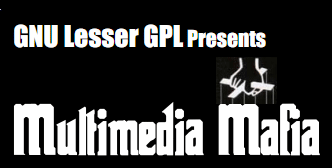FFmpeg and associated open source multimedia projects such as xine, MPlayer, and VLC have long had a rebel mystique about them; a bunch of hackers playing fast and loose with IP law in order to give the world the free multimedia experience it deserved. We figured out the algorithms using any tools available, including the feared technique of binary reverse engineering. When I gave a presentation about FFmpeg at Linuxtag in 2007, I created this image illustrating said mystique:

It garnered laughs. But I made the point that we multimedia hackers just press on, doing our thing while ignoring legal threats. The policy has historically worked out famously for us– to date, I seem to be the only person on the receiving end of a sort-of legal threat from the outside world.
Who would have thought that the most credible legal threat to an open source multimedia project would emanate from a fork of that very project? Because that’s exactly what has transpired:

Click for full threat
So it came to pass that Michael Niedermayer — the leader of the FFmpeg project — received a bona fide legal nastygram from Mans Rullgard, a representative of the FFmpeg-forked Libav project. The subject of dispute is a scorched-earth matter involving the somewhat iconic FFmpeg zigzag logo:
 |
 |
|
| Original 2D logo | enhanced 3D logo |
To think of all those years we spent worrying about legal threats from organizations outside the community. I’m reminded of that time-honored horror trope/urban legend staple: Get out! The legal threats are coming from inside the house!
I’m interested to see how this all plays out, particularly regarding jurisdiction, as we have a U.K. resident engaging an Italian lawyer outfit to deliver a legal threat to an Austrian citizen regarding an image hosted on a server in Hungary. I suspect I know why that law firm was chosen, but it’s still a curious jurisdictional setup.
People often used to ask me if we multimedia hackers would get sued to death for doing what we do. My response was always, “There’s only one way to know for sure,” by which I meant that we would just have to engage in said shady activities and determine empirically if lawsuits resulted. So I’m a strong advocate for experimentation to push the limits. Kudos to Michael and Mans for volunteering to push the legal limits.
First, you forget Fabrice who decided to register FFMPEG trademark in France (http://bases-marques.inpi.fr/Typo3_INPI_Marques/marques_recherche_marques.html input “ffmpeg” in “Nom de la marque” field and see). So you got silly stuff started by FFmpeg creator himself.
Second, we just knew one Italian lawyer who agreed to help, hence the choice.
And last, it’s still not about codec development, so keep watching.
Personally I support that notion – the less confusion between FFmpeg and Libav here the better. And since original 2D logo was created by MÃ¥ns and he’s part of Libav community I see no reason why Libav should give up the logo (and Michael seemed to ignore subtler hints).
He should just comply. It’s not a well-known logo, and certainly not amazing enough to fight over.
mans had a problem with michaels’ redrawn logo, so i’m guessing the same problem will exist with herve’s, unless herve posted his logo before mans did?
someone said you cannot patent a mathmatical equation, and thats mostly correct. except we are talking about a copyrighted logo. can you take at&t’s deathstar logo and render it in 3d and use it to start another telephone company?
of course mans’ logo is based on michaels original drawing of the logo, so all bets are off. its such a dumb waste of time for all involved.
@Mike, you forgot to mention that the server is located in Hungary.
@Kostya.
A lot of people participated in the creation of the old logo. Mans cannot claim that he is the only and the sole author of the logo. He was indeed the person to do the final touch. That’s why Michael first respond 2.5 moths ago was to recreate the logo on his own.
Here is the original Michael proposal for a logo. You can see that it contains the 4×4 zig-zag pattern.
http://article.gmane.org/gmane.comp.video.ffmpeg.devel/28816
I’m not quite sure about laws covering works with multiple co-authors and disputes among them. But if somehow FFmpeg is legally barged from using the logo, then most certainly LibAV won’t be able to use anything resembling 4×4 zigzag either.
If you really want less confusion between FFmpeg and LibAV, you should avoid the logo that FFmpeg project used for years (no matter who owns it).
@Ivan: Thanks for the reminder; I’ve updated the sentence: U.K. -> Italy -> Austria -> Hungary. I probably can’t find any of those on a map.
Looks like Mans is just a big whiny baby.
I propose this new logo: http://i54.tinypic.com/1r4v2r.png
I would be happy to release it to the public domain.
i know i can find italy on a globe because its the one that looks like a boot! :)
2nd grade geography saves me again!
@compn: I think I got that same nugget from a breakfast cereal commercial. Sad, but there it is.
@compn: in the AT&T example, they would likely sue the competitor for abuse of trademark. That’s different to the copyright issue at hand here.
In this case, the particular image probably has some sort of copyright courtesy of being a product of Rullgard’s photoshop session. The reworked logo wouldn’t infringe on that.
However, it really seems to be a childish and disgusting move to me. He expressed that he puts the logo at ffmpeg’s disposal too.
In any case, it’s better to show a finger to such people imho rather than wasting time arguing with them. Getting a new logo instead was probably a good idea.
found this post while digging around.
http://ffmpeg.org/pipermail/ffmpeg-devel/2009-February/065878.html